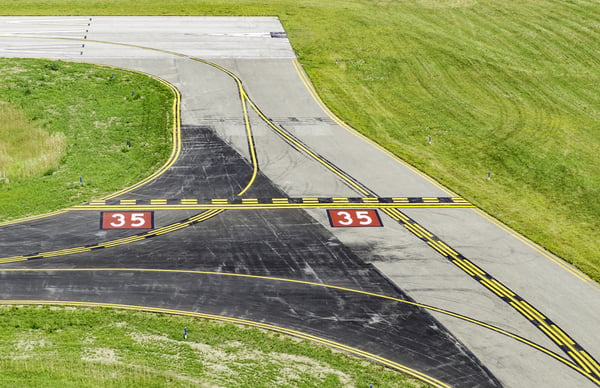RJ Lee Group 5 min read
Airport Solves PFAS Dilemma when Resurfacing Concrete
CATEGORIES
Contributors
RJ Lee Group
Subscribe to our newsletter
Determining PFAS Contamination in Concrete Requires Specialized Testing Methods
When an airport in the Pacific Northwest needed to resurface a runway, it found that landfills and recyclers were unwilling to accept milled concrete due to environmental concerns over the potential of PFAS contamination from the Aqueous Film-Forming Foam (AFFF) commonly used at airports.

As a smaller, private regional airport that had no documented use of AFFF, it needed proof that its concrete did not pose an environmental hazard. While testing for PFAS in water has become increasingly standardized, testing for PFAS in concrete presents unique challenges that demand specialized expertise and multi-disciplinary analysis.
What are PFAS?
PFAS are a group of synthetic chemicals that include PFOA, PFOS, HFPO-DA (GenX), and many others. They are known for their durability and resistance to water, oil, and heat, which makes them useful in numerous industrial and consumer products, including Aqueous Film-Forming Foam (AFFF), commonly used at airports to fight fuel-based fires.

In AFFF, a thin aqueous film spreads over the surface of flammable liquids, cutting off the oxygen supply and suppressing vapor release, which helps extinguish the fire quickly. The durability of PFAS also means that they do not break down easily in the environment, leading to contamination and health concerns. Due to these growing concerns, the FAA mandated that airports can no longer use AFFF that contains PFAS as of 2024.
Why Is Testing for PFAS in Concrete More Complex?
Concrete is a highly porous material with a complex matrix that can absorb and trap PFAS differently from liquid samples. Unlike water, which provides a uniform medium for PFAS distribution, concrete presents multiple variables that affect sample collection, extraction, and analysis. These factors include:
- Heterogeneous Composition: Concrete often contains aggregates, cement paste, and air voids that create uneven PFAS distribution.
- Surface vs. Depth Contamination: PFAS may accumulate in surface layers or penetrate deeply into the concrete structure, requiring precise sampling techniques.
- Chemical Interference: Concrete’s alkaline nature and mineral content can interfere with PFAS extraction and detection methods.
The Need for a Multi-Disciplinary Approach
Given these complexities, labs that offer PFAS testing for drinking water generally lack the resources to prepare, test, and analyze concrete samples properly. Conversely, labs that provide concrete testing services focus on mechanical strength and durability over chemical analysis. Adding further complication, concrete from a runway may contain fuel, oil, de-icing chemicals, and other unknown compounds that preclude standardized testing methods.

RJ Lee Group offers expertise in both chemical analysis and petrography, and we specialize in scientific investigation and problem-solving, making us well-suited for this unique challenge.
- Chemical Analysis Expertise: Specialized equipment like LC-MS/MS (Liquid Chromatography-Mass Spectrometry) is essential for detecting PFAS at trace levels
- Petrographic Analysis: Understanding the concrete’s microstructure helps identify pathways for PFAS migration and guides sampling strategies.
- Material Science Knowledge: Insight into concrete composition and environmental exposure conditions is crucial for interpreting results and developing remediation strategies.
- Investigative Analysis: Analyzing the unknown to determine its makeup, unique fingerprint, and possible origin requires a multi-disciplinary approach.
- Industry Experience: A long history of working with civilian and military airports, as well as construction and building trades, provides valuable insights.
Why Partner with RJ Lee Group?
RJ Lee Group’s extensive experience in both PFAS analysis and materials science made us the perfect choice to verify the airport’s claim of PFAS-free concrete. We worked closely with the airport to determine the best procedure for sample collection to ensure an appropriate sample size and distribution. Samples were first sent to the RJ Lee Group petrography lab for initial preparation, then to our chemistry lab for LCMS analysis
Detailed analysis of the concrete samples proved the airport's claim that AFFF, and therefore PFAS, was not found in the milled concrete. As a result, the concrete could be sent directly to a landfill for disposal without additional environmental containment and the additional cost this would entail. The cost savings easily outweighed the cost of testing and allowed everyone involved to be confident that they were not introducing PFAS to the environment.



